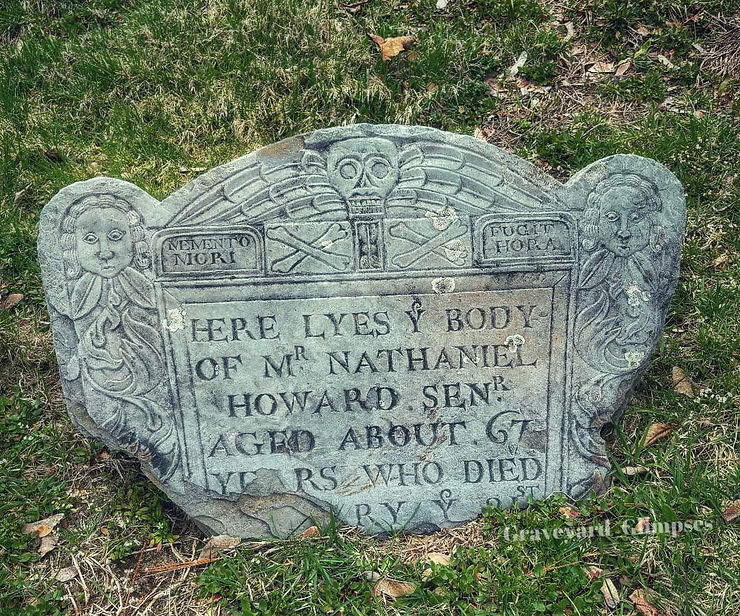Unveiling the Symbolism of Colonial-Era Gravestones - Part One
- B
- Jan 15
- 3 min read
A stroll through the historic cemeteries of the original 13 colonies on the East Coast reveals a fascinating array of gravestones, with dates spanning from the early 17th century to the present day. These ancient stones boast intricate carvings that reflect the artistic tastes of their time and convey symbolic meanings that offer a glimpse into our ancestors' cultural, social, and religious beliefs.
As we delve into the world of colonial-era gravestones, we will explore the diverse symbols that adorn these monuments, including skulls with wings, cherubs, and angles. Each of these symbols carries its distinct meaning, influenced by the historical context, regional traditions, and personal preferences of the deceased and their families.
Through this blog, we will navigate the evolution of gravestone symbolism over the centuries, examining how these motifs changed in response to shifting cultural values, religious influences, and artistic trends. By deciphering the language of these symbols, we will gain a deeper understanding of the lives and times of those who came before us and appreciate the enduring legacy of these colonial-era gravestones.
During the colonial era, tombstones in America’s early burial grounds often featured a distinctive symbol: the Winged Skull. This eerie yet fascinating image has captivated historians, genealogists, and enthusiasts of colonial American culture.
Origins of the Winged Skull
The Winged Skull motif originates in 17th-century Europe, particularly in England and Scotland, where it was used to symbolize mortality and the transience of
human life (Taterka, 2013). As European settlers arrived in America, they brought this symbol with them, incorporating it into their tombstone designs.

Meaning and Interpretation
The Winged Skull was often accompanied by inscriptions that reinforced its message of mortality. These inscriptions might include phrases like “Memento Mori” (Remember Death) or “Vanitas Vanitatum” (Vanity of Vanities), emphasizing the fleeting nature of human existence (Ludwig, 1966).
The wings attached to the skull were meant to represent the soul’s ascension to heaven, while the skull itself symbolized the physical body’s return to dust (Farrell, 1980). This dichotomy between the spiritual and physical realms was familiar in colonial American funerary art.
Examples and Variations
Winged Skulls can be found on tombstones throughout colonial America, from the oldest burial grounds in New England to those in the southern colonies. Some notable examples include:
The Old Burying Point Cemetery in Salem, Massachusetts, features several Winged Skull tombstones dating back to the 17th- century (Salem Witch Museum, n.d.).
The Granary Burying Ground in Boston, Massachusetts, where visitors can find Winged Skull tombstones, including one marking the grave of Paul Revere (Boston Historical Society, n.d.).
Over time, the Winged Skull motif underwent variations, with some carvers adding additional symbols, such as crossbones, hourglasses, or snakes (Tashjian, 1974). So, in conclusion. The Winged Skull on colonial-era tombstones serves as a poignant reminder of mortality and the transience of human life. This symbol, born from European traditions and adapted in America, continues to captivate audiences with its eerie beauty and profound message.
Sometimes, during the colonial era, tombstones in America often featured arrows. These arrows, often pointing downwards or upwards, held significant meaning and conveyed messages about mortality, transition, and the afterlife.
Origins and Meaning
Arrows on tombstones originated in Europe, specifically in England, where they were used to symbolize the soul’s journey to the afterlife (Tashjin,1974, p.23). In colonial America, arrows were often used in conjunction with other symbols, such as imps, saintly figures, more arrows, or even stabbing a skull.
The direction of the arrow was also significant. Downward-pointing arrows often symbolized the soul’s descent into the grave, while upward-pointing arrows represented the soul’s ascension to heaven (Ludwig, 1966, p. 45). Sometimes, if the arrows are accompanied by a saintly figure, it refers to Saint Sebastian, while three arrows bound together are usually the symbol of brotherly love and respect (Tui, 2017, p.177).
Examples from Colonial-Era Cemeteries
Arrows can be found on tombstones throughout colonial America, from the oldest burial ground in New England to those in the Southern colonies. Some notable examples:
The Myles Standish Burial Ground in Duxbury, Massachusetts, features a tombstone with an upward-pointing arrow, symbolizing the soul’s ascension to heaven (Duxbury Rural and Historical Society, n.d.).
The Ancient Burying Ground in Hartford, Connecticut, is where visitors can find a tombstone with a downward-pointing arrow, indicating the soul’s descent into the grave (Hartford Preservation Alliance, n.d.).
The Magnolia Cemetery in Charleston, South Carolina, features a tombstone with an arrow pointing upwards, surrounded by other symbols, such as skulls and crossbones. (Magnolia Cemetery Trust, n.d.).
Please come back next week to learn more.
See ya next week!
- B





Comments